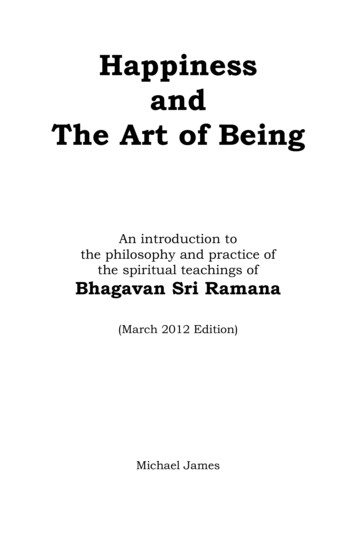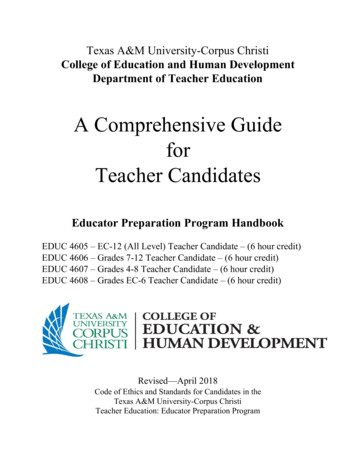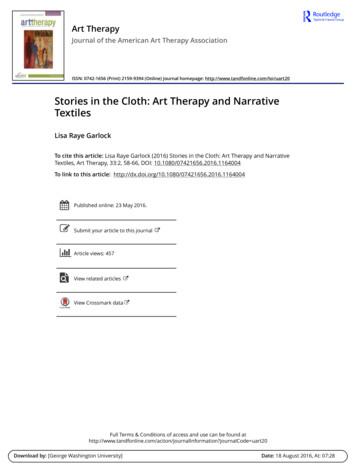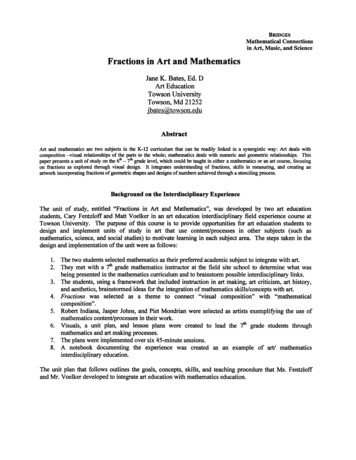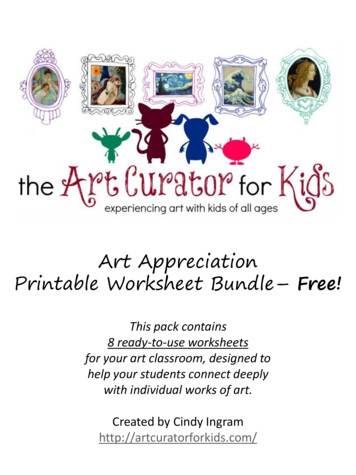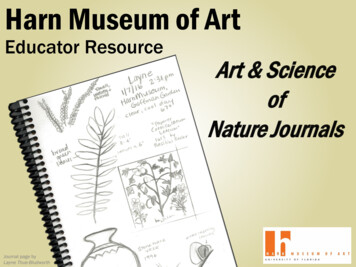
Transcription
Harn Museum of ArtEducator ResourceJournal page byLayne Thue-BludworthArt & ScienceofNature Journals
Nature Journals & Scientific IllustrationNature Journals – Integrating Diverse DisciplinesObservationNature Journals are powerful curriculum tools for the classroomthat can bring together math, language arts, local history, and evenphysical education. They also encourage observation and criticalthinking about the world while actively engaging students throughthe use of their senses.Nature journaling develops and refines observation anddocumentation skills, which are essential to the scientificprocess as well as other school subjects. Even thoughphotographs of specimens are now easily available to studyfrom, the act of drawing from observation requires studentsto look closely and pay attention to details that may havebeen overlooked otherwise.Through nature journaling, students can learn about relationshipsamong plants, animals and humans as well as systems of the earth.Weather, rocks, soil and water are transformed from abstractconcepts into tangible elements. Perhaps most importantly, naturejournaling encourages students to study where they live and howthey relate to the environment.Scientific Illustration - Studying Nature Through ArtScientific illustration is art that reflects the findings and ideas ofscience. It is often a way to visually communicate information that isotherwise unobservable – including atomic elements, internalanatomies, extinct life forms and even the expanse of the universe.Scientific illustrators are artists in the service of science.Before the invention of photography, detailed and realisticillustrations of plants and animals assisted in species identificationand contributed to an understanding of life cycles and habitats.Artists such as Maria Sibylla Merian and Basilius Besler were artistsand naturalists who observed plants and animals carefully, thenillustrated their observations in such great detail that we can stilllearn from them today.Educational Power of DrawingIn recent years, scientists have started to explore theeducational power of drawing. Research shows that drawingserves as an anchoring task to increase information retentionand recall. Even more remarkable, researchers have alsofound that drawing improves comprehension, especially forcomplicated concepts and processes. A study published inScience in 2011 revealed that when students create theirown visual representations of ideas and concepts, they havea considerably deeper learning experience.Study the science of art. Study the art ofscience. Develop your senses – especiallylearn how to see.- Leonardo da Vinci
Maria Sibylla MerianMaria Sibylla Merian (German, 1647 – 1717)Maria Sibylla Merian was an entomologist, botanist, naturalist, and artist. Merianwas born in Germany, where she learned about painting and engraving from herfamily. She started studying insects at the age of 12, and at age 13, painted her firstimages of insects and plants from specimens she collected. Throughout her career,Merian focused on illustrating insects, their habitat and food sources, and theprocess of metamorphosis. During the 17th century, it was not well-understood how acaterpillar changed into a butterfly. Because of Merian’s careful observation anddocumentation of the stages of development and process of metamorphosis in herbook Metamorphosis Insectorum Surinamensium, she is considered to be asignificant contributor to the field of Entomology. Six plants, nine butterflies, and twobeetles are named for her.Achiote(Bixa Orellana)Mature tree withseed podsPhoto by J.M. GargLeft: FlowerRight: Matureseed podsPhoto by Arria BelliPlate 44, From MetamorphosisInsectorum Surinamensium(see larger image provided in this resource)Plate 44 from Metamorphosis Insectorum SurinamensiumThis image shows a stem and inhabitants of the Achiote (Bixa orellana), a smalltree from the tropical region of South America. Merian observed and illustratedthe plant during her work in Surinam, and her text accompanying the platerefers to it as the Urucu tree – the plant’s original name used by Tupi-speakingnative South Americans.The plate shows the Achiote’s pink flowers and red-brown seed pods, with oneopen to reveal the red seeds inside. Originally used to make body paint andlipstick, the seeds are still used today to make yellow to reddish-orange foodcoloring.The insects inhabiting the plant represent the life cycle of two species – with acaterpillar, chrysalis and adult of each. In her written notes, Merian recordeddetailed descriptions of the caterpillars and the dates they transformed intodifferent stages of their life cycles.
Basilius BeslerBasilius Besler (German, 1561 – 1629)Basilius Besler was an apothecary (early pharmacist), botanist and collector of naturalhistory specimens. At the request of the ruling bishop, Besler created a botanical gardenat Willibaldsburg castle. He then produced a plant atlas, Hortus Eystettensis, thatpresented detailed and accurate images of every plant in the garden. Published in 1613,it was the most modern book on plants of its time.Garden of Willibaldsburg Castle, designed by BeslerPhoto by Dark Avenger commonswikiPapaver Corniculatum LuteumThe central plant in this print,Papaver Corniculatum Luteum,was commonly called HornedPoppy with a Yellow Flower, orYellow Hornpoppy. It was knownto cause disorientation andvisions if consumed. Today,certain types of poppy plants areused to make medicines to treatsevere pain.Plants & MedicinePlants can effect the human body in avariety of ways, such as relieving pain(willow bark) and changing heart rate(foxglove). Because of this, plants werethe primary source of medicine forthousands of years. Early pharmacistsand physicians relied on detailed andaccurate images in order to make surethey used the correct plants fortreatments.Yellow Horned Poppy.Photo by Stan ShebsViola Tri-color.Photo by Jörg HempelPapaver Corniculatum Luteum, 1613From Hortus Eystettensis, Eichstatt(see larger image provided in this resource)Trinitatis ViolaceusThe smaller flowers includedin the lower left and right ofthis print are differentvarieties of the flower Violatricolor. This flower wasused in folk medicineto treat respiratoryproblems such asbronchitis, asthma andcold symptoms. Modernresearchers havefound chemicals in Violatri-color that have beenuseful in developingnew medicines.
Lesson: Observation & CommunicationBy Emma Roulette, Science Teacher, Alachua County Public Schools, Westwood Middle SchoolObjectivesActivity Students will be able to understand howobserving an image and representing thatimage are connected through a process ofcommunication.1. Have students get into pairs and determine who will be the artist and who willbe the observer. The artist is not allowed to talk. The observer must keep theirhands behind their back at all times.2. The observer will visit the mystery object and observe it. Then the observer willreturn to the artist and explain how to draw the object.3. The observer may not touch the artist’s pencil at any time, use hand gestures,or say the name of the object.4. After time is called, reveal the object to all the groups. Students will be able to communicatemore effectively by learning to createprecise instructions. Students will understand the detailed andobjective observation skills necessary toproduce images that effectively representreality.Pre-Activity / SetupFind an object that is not easily recognizable,and that is composed of several parts, suchas an old camera, a classroom anemometer,or a strange old musical instrument. Becreative!Post- ActivityHave a guided discussion with your class. Ask these questions to get the discussiongoing:1. How was your drawing different from what the mystery object looks like? Howwas it similar?2. What specific words did you use to explain your observations to someone else?3. How could instructions be improved to help the drawing look more like themystery object?4. How is the activity you did in partners like the act of one person drawingsomething they see? How is it different?The most important thingwe can teach our youngpeople is to observe well.- Ernst Mayr, evolutionary biologistRobinson AnemometerPhoto by Mr. Sean LinehanVintage 8mm Movie CameraPhoto by Joe HauptSitar. Photo by UniversidadNacional de La Plata
Lesson: Observation & DrawingObserving expandsyour world.- Clare Walker Leslie & Charles E. RothAuthors, Keeping a Nature JournalBlind Contour DrawingActivityIntroduce students to nature journals and prepare them forobservational drawing and field studies with a quick and stressfree warm up exercise – Blind Contour Drawing. This lessonactivates right brain thinking, focuses students’ observationskills, and encourages the hand, eye and brain to work together.Because students draw without looking at their paper, it alsoalleviates any concerns with results. Discuss the idea of warm-up exercises for a variety of activities,such as stretching before athletics and practicing scales beforea music performance. They are not done with results in mind.Their purpose is to prepare the body and mind for a specificactivity and to improve basic skills.Supplies Objects for students to draw – one per seating group, placedon desks/group tables. Everyday objects with little surfacedecoration work best – cups, bottles, vases, baskets Paper – 2 sheets per students, one to draw on and the otherto slide over the top of their pencil to hide their drawing hand(see picture below) PencilsSample subject, result & hidden drawing hand Set a time limit for the drawing – 1 minute. With pencil and paper hidden from view and ready, havestudents carefully observe the object to draw. They should picka point on the object where their eye can begin a slow journeyaround the contour, or edge. As their eye moves along the contour, students should drawexactly what they see, without lifting their pencil from paper. Students should not look at their drawing, only the object. Theireyes should remain on the object during the entire drawingtime.Post-ActivityWhen time is up, have students look at their drawing. Discusswhether anyone drew a realistic picture of their object. (Probablynot.) Is anyone able to recognize the object they drew? Moststudents will say yes, and since nobody peaked at their drawing,this is remarkable.If time permits, have students do another contour drawing of thesame object, but allow them to look back and forth between theobject and their drawing.
Lesson: Nature Journal PagesObjectives Scientific illustrations will inform andinspire students to explore the naturalworld around them. Students will strengthen observationskills and practice recording details ofplants in notes and sketches.Supplies Collection of different, natural leaves (atleast one for each student) Pencils Nature Journals or paper Crayons or colored pencils (optional)You really do not see aplant until you draw it.- GoethePre-ActivityChoose one or more of the scientific illustration prints in this resource to share with students.Discuss the elements of details provided in the illustrations, such as colors, shading,leaf/flower shapes and sizes, parts of plants, and even withering or drooping elements.Classroom Activity Following a Blind Contour Drawing warm-up (see lesson provided), have each studentselect a leaf from those collected. Before picking up paper and pencil, students should spend 3-5 minutes studying their leafclosely. Instruct them to look for details such as length, width, color, shape, texture, andpattern of veins. Then, students should move their leaf out of sight and draw it from memory. Using justpencils, students should draw a life-size line drawing. Allow about 5 minutes. When drawings are completed, students can compare their drawings to the leaves. Howmany details were they able to remember and include? How is the drawing different? Iftime permits, students can do another drawing while looking at their leaf. Crayons orcolored pencils can be used to further describe their leaf.Field Activity Have students work in pairs. With nature journals and pencils in hand, take the class to asite on campus that has a variety of plants. Ask student partners to choose one plant that interests them. Give students 5-10 minutesto draw a sketch and write descriptive notes of their plant in their individual journals. When sketching is completed, partners can compare their drawings to the plant. Did eachstudent include different details? Would other classmates be able to find their selectedplant based on their drawings?
Curriculum Web for Nature JournalingSocial StudiesEarth SciencePlantsInsectsBirdsOther animalsTrees andshrubs Habitats andseasons ngNatureJournalingPhysical Education Walking and exploring Outdoor activity HikingLanguage Arts Written: poetry, prose, fiction,nonfiction Oral: description, problem solving,communication Listening: group communication,group sharing, oral learning Local history Natural and humancommunities Environmental health in history MapmakingArt Hand-eye skillsSelf-confidence and social skillsLearning to compose work supportivelyObservational drawingDifferent forms of art expressionMapmakingMath : Keeping a Nature Journal by Clare Walker Leslie & Charles Roth, Storey Publishing, 2003.
Maria Sibylla Merian, German, 1647 - 1717Plate 44, 1705From Metamorphosis Insectorum Surinamensium,AmsterdamEngraving, hand-coloredMuseum purchase, funds provided by Kevin andMargaret Harrington, 2010.27.5
Basilius Besler, German, 1561 - 1629Papaver Corniculatum Luteum, 1613From Hortus Eystettensis, EichstattInk on paperMuseum purchase, funds provided by PeterDescorcy, with additional funds provided by GladysHarn Harris Art Acquisition Endowment, 2010.30
Additional image forreference & inspirationElizabeth BlackwellScottish, 1707-1758Avens or Herb Bennet1739Engraving, hand coloredFrom A Curious Herbal (London, 1739)Museum purchase, funds provided by Peter DeSorcy2011.11.2This plate depicts Avens or Herb Bennet, known today as Geumurbanum L. It was believed to be effective for treating poison and dogbites, liver disease, catarrh and stomach distress. More recently, it hasbeen used to treat diarrhea, heart disease, halitosis and ulcers of themouth. The accompanying text also claims the roots are “cordial andcheering to ye Spirits, when infused in Wine” (volume 2). Blackwell’sillustration includes two specimens, one that has been cut at the stem,and the other which is still connected to a large root full of offshoots.She also shows flowers in various stages of bloom as well as details ofa flower, seed vessel and seed.
Additional image forreference & inspirationJane Webb LoudonBritish, 1807 - 1858Various Nigellas, Plate 2 from The Ladies’ Flower Garden (London,1840)c. 1840Lithograph, hand-coloredMuseum purchase, funds provided by Dr. Richard Tavernetti,2012.1.2Jane Webb Loudon was an accomplished author of poetry,horticultural guides, children’s books and science fiction. In 1830,she married John Claudius Loudon, a renowned landscapearchitect. Eager to help her husband in his work, she attendedlectures on botany and accompanied him on tours of gardens andconservatories. Through her attractively illustrated books, shehoped to promote a taste for gardening as art and to make thesubjects of horticulture and natural science more accessible topopular audiences.In order to make the subjects of botany and horticulture moreinteresting to her readers, Loudon avoided overly technicallanguage and emphasized “how-to” methods of gardeningprojects. Each of her illustrations for The Ladies’ Flower Gardenshows rich coloring, attention to detail and sensitivity tocomposition.
Additional image forreference & inspirationAlbert Seba, German, 1665 - 1736Table LXXIV (74), 1734-1755From Locupletissimi Rerum Naturalium Thesauri (Book 3), AmsterdamInk on paperMuseum purchase, funds provided by Ben M. Carter in honor ofEnrique R. Anderson (Class of '95) and Family, 2014.29.22Albert Seba's magnificent "Thesauri" is a catalogue of his personalnatural history collection, an immense conglomeration of specimens ofa number of exotic plants and animal life. His scientific interests andcuriosity motivated him to amass this collection on a series of travelsto the East and West Indies, and from purchases he made ofspecimens collected by travelers around the world. Seba’s collectionwas a valuable source to European natural historians, many of whomwould not have had the opportunity to travel to the far flungdestinations where the specimens originated.
ResourcesBooks Brady, Irene. Illustrating Nature: Right Brain Art in a Left-brain World, Nature Works Press, 2011. Brown, Sunni. The Doodle Revolution, Penguin Group, 2014. Laws, J., Breunig, E., Lygren, E., & Lopez, C. (2012). Opening the world through nature journaling:Integrating art, science & language arts (2nd ed., pp. 1-12), Sacramento, California: CaliforniaNative Plant Society. Leslie, Clare Walker & Charles E. Roth. Keeping a Nature Journal, Storey Publishing, 2003. Tomlinson, Susan Leigh, How to Keep a Naturalist’s Notebook, Stackpole Books, 2010.Web Botany Handbook, from University of Florida (identify plant structures and forms):http://edis.ifas.ufl.edu/mg012 Drawing to Learn ll?ijkey aY10Lee0qxtjI&keytype ref&siteid sci Nature Journaling - Project Learning Tree - ith-plt Sketching and Drawing in Science Class http://www.plantingscience.org/index.php?module content&func view&pid 118 Smithsonian In Your Classroom, Nature Journals on plans/journals/
from, the act of drawing from observation requires students . Before the invention of photography, detailed and realistic illustrations of plants and animals assisted in species identification and con
